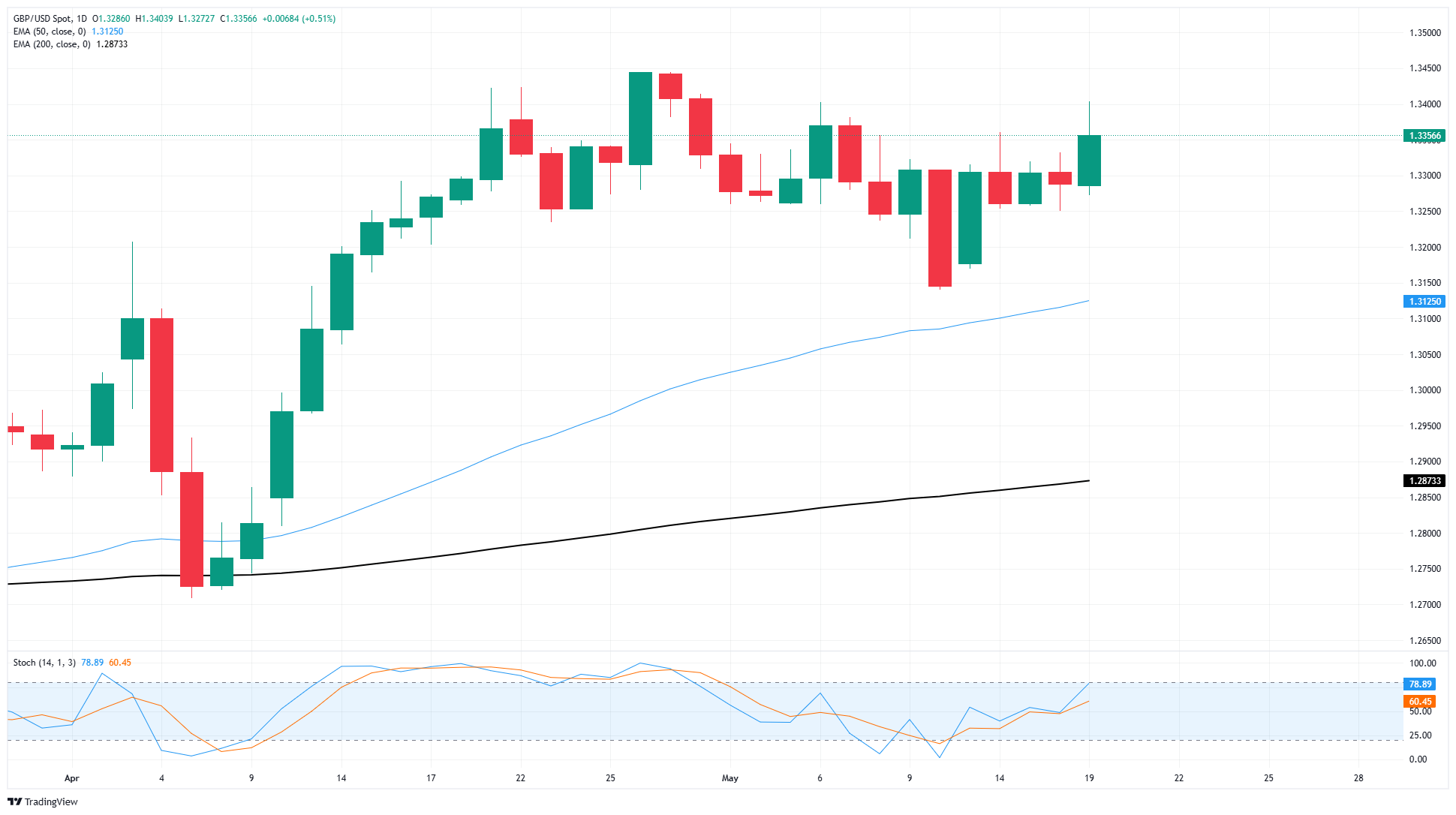GBP/USD breaks above recent consolidation on fresh Greenback weakness

- GBP/USD rallied on Monday, tapping the 1.3400 handle once again.
- The Greenback shed weight on Monday as investor sentiment remains stubbornly high.
- UK CPI inflation data due on Wednesday, US PMI figures slated for Thursday.
GBP/USD rose at the outset of the new trading week, briefly testing the 1.3400 handle for the second time in two weeks. Despite an early bullish push in cable bids, buyers couldn’t lock in a fresh high, and price action trimmed back to a more sedate 1.3350.
Moody’s ratings agency stripped the United States (US) of its last remaining AAA rating on its Treasuries last Friday, citing burgeoning US debt and government deficits that successive presidential administrations either refuse to, or are incapable of, bringing under control. Investor sentiment wobbled at the headlines, but quickly recovered and shrugged off the hit to US creditworthiness. Still, not all is perfectly rosy in the Treasury markets: 30-year yields broke above 5% on Monday, and 10-year yields traded north of 4.5%.
Federal Reserve (Fed) speakers have hit the ground running this week to temper market expectations for rate cuts. All Fed policymakers have been gently but firmly reminding investors that the US’s still-existing tariff and trade policies make it nearly impossible to forecast the domestic economy, and adjust policy rates as a result.
The latest UK Consumer Price Index (CPI) inflation is scheduled to release on Wednesday, and is expected to jump appreciably on both a monthly and annualized basis. Core UK CPI inflation is forecast to rise to 3.7% YoY from 3.4%. The key economic data release this week on the US side of the Pacific will be S&P Global Purchasing Managers Index (PMI) figures for May. According to median market forecasts, both the manufacturing and services components of the PMI report are expected to decline slightly as tariffs take a bite out of business spending activity.
GBP/USD price forecast
Despite an early bullish push to kick off the new trading week, Cable bids remain constrained. Headlines continue to drive most of the market action. 1.3400 remains a firm line in the sand that bidders either cannot or will not cross, but price action continues to trade firmly to the north side of the 50-day Exponential Moving Average (EMA) near 1.3100.
GBP/USD daily chart
Pound Sterling FAQs
The Pound Sterling (GBP) is the oldest currency in the world (886 AD) and the official currency of the United Kingdom. It is the fourth most traded unit for foreign exchange (FX) in the world, accounting for 12% of all transactions, averaging $630 billion a day, according to 2022 data.
Its key trading pairs are GBP/USD, also known as ‘Cable’, which accounts for 11% of FX, GBP/JPY, or the ‘Dragon’ as it is known by traders (3%), and EUR/GBP (2%). The Pound Sterling is issued by the Bank of England (BoE).
The single most important factor influencing the value of the Pound Sterling is monetary policy decided by the Bank of England. The BoE bases its decisions on whether it has achieved its primary goal of “price stability” – a steady inflation rate of around 2%. Its primary tool for achieving this is the adjustment of interest rates.
When inflation is too high, the BoE will try to rein it in by raising interest rates, making it more expensive for people and businesses to access credit. This is generally positive for GBP, as higher interest rates make the UK a more attractive place for global investors to park their money.
When inflation falls too low it is a sign economic growth is slowing. In this scenario, the BoE will consider lowering interest rates to cheapen credit so businesses will borrow more to invest in growth-generating projects.
Data releases gauge the health of the economy and can impact the value of the Pound Sterling. Indicators such as GDP, Manufacturing and Services PMIs, and employment can all influence the direction of the GBP.
A strong economy is good for Sterling. Not only does it attract more foreign investment but it may encourage the BoE to put up interest rates, which will directly strengthen GBP. Otherwise, if economic data is weak, the Pound Sterling is likely to fall.
Another significant data release for the Pound Sterling is the Trade Balance. This indicator measures the difference between what a country earns from its exports and what it spends on imports over a given period.
If a country produces highly sought-after exports, its currency will benefit purely from the extra demand created from foreign buyers seeking to purchase these goods. Therefore, a positive net Trade Balance strengthens a currency and vice versa for a negative balance.
